- ● homepage
- ● archives
- ● restoration
- ● books
- ● big banners
- ● post board
- ■ neo's search
- ■ about us
- ■ 게재방법 안내
- 개인정보처리방침

- [email protected]
- Tel. 02_335_7922
- Fax. 02_335_7929
- 10:00am~04:30pm
- 월요일~금요일
- 3/3(월) 대체공휴일

에코토피아를 향한 명상 Meditation Seeking for Ecotopia
김혜원展 / KIMHYEWON / 金惠苑 / photography 2016_1028 ▶ 2016_1030
● 위 이미지를 클릭하면 네오룩 아카이브 Vol.20160406i | 김혜원展으로 갑니다.
아티스트 토크 / 2016_1029_토요일_02:00pm
2016 컨템포러리 아트 루르-이노베이티브 아트페어 2016 Contemporary Art Ruhr-Innovative Kunstmesse
기획 / 김선정 후원 / 한국문화예술위원회_전라북도_전북문화관광재단
관람시간 / 10:00am~06:00pm
독일 에센 세계문화유산 졸페라인 Unesco World Heritage Zollverein in Essen, Germany galerie/agentur 162: contemporary art ruhr(C.A.R.)Neukircher Mühle 29. 45239 Essen. Tel. +49.201.5646.500 contemporaryartruhr.de
『에코토피아를 향한 명상』은 전북문화관광재단의 해외전시지원사업에 선정되어 독일 에센 유네스코 세계문화유산 졸페라인에서 열리는 『2016 컨템포러리 아트 루르-이노베이티브 아트페어(Contemporary Art Ruhr-Innovative Kunstmesse)』에 참가하는 개인전이다. 이 전시는 인간의 손에 의해 훼손되는 자연 환경과 문명에 의해 변화되는 지형을 소재로 '녹색(Green)'으로 상징되는 에코토피아의 세계를 지향하는 풍경 사진들을 대상으로 하였다. 즉 에콜로지(ecology)를 작업 논리로 하여, 산업자본주의 소비 문화 시대의 파괴되고 변형되고 소비되고 있는 지형과 환경에 대한 작업을 일관되게 보여주는 데 초점을 맞춘 것이다.

- 김혜원_용담댐 시리즈-풍경 #01_피그먼트 프린트_11×14inch_1999
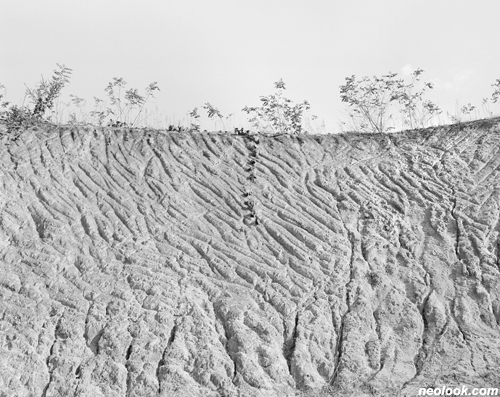
- 김혜원_용담댐 시리즈-풍경 #27_피그먼트 프린트_11×14inch_1999
「용담댐 시리즈-풍경」(2001)은 '용담댐' 건설 공사와 수몰 도로의 이설 공사로 광범위하게 국토가 파괴되고 자연이 침탈되고 있는 전북 진안군 '용담' 마을의 변화되는 지형을 소재로 삼았다. 「Commercial Landscapes」(2006)는 자연 속 유료화된 레저 스포츠 인공 시설물들을 통해, 자연이 고가의 상품이 되어 소비를 부추기고 있는 상업화된 풍경과 지형을 기록하였다. 「34개의 야외 주차장」(2009)은 '땅'이라는 '자연' 풍경을 아스팔트와 시멘트와 철판, 직선과 화살표라는 기호의 '인공' 경관으로 변화시켜 놓은 자연 속 야외 주차장을 통해, 환경 파괴와 소비 문화라는 사회문화적 현실을 보여주었다. 「금수강산 프로젝트-인공 해수욕장」(2014)은 수중보를 쌓아 바다를 막고 외지에서 퍼 온 모래를 갯벌에 깔아 해변 데크까지 조성해 놓은 인공 해수욕장을 통해 금수강산의 의미와 가치를 탐색하였다.
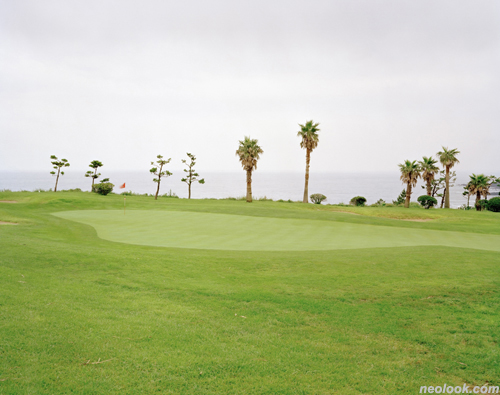
- 김혜원_Commercial Landscapes #01_디지털 C 프린트_11×14inch_2003

- 김혜원_Commercial Landscapes #08_디지털 C 프린트_11×14inch_2004
이처럼 한국적 풍경의 현주소를 포착하여 자본주의 시대의 지형과 지리, 물질 문명과 소비 문화의 실상을 기록한 이 사진들은 시대 현실과 사회 상황에 대한 아카이브 작업임에도 불구하고 다큐멘터리 사진과 예술 사진의 불투명한 경계에 서고자 하였다. 원근법을 파괴한 정면성, 주관을 배제한 객관성과 중립성, 대상과의 일정한 거리, 차분한 관찰자의 시선, 중간 톤과 파스텔조의 컬러, 조형적이고 미니멀한 이미지 등의 절제된 어법과 형식 미학을 바탕으로 시적(詩的)이고 서정적인 분위기를 드러내고자 하였다. 프로파간다적 문명 비판이나 환경 옹호를 표방하지 않고 리얼리티와 일루전, 이들의 길항과 균형이라는 미학적 시각을 잊지 않고자 하였다.
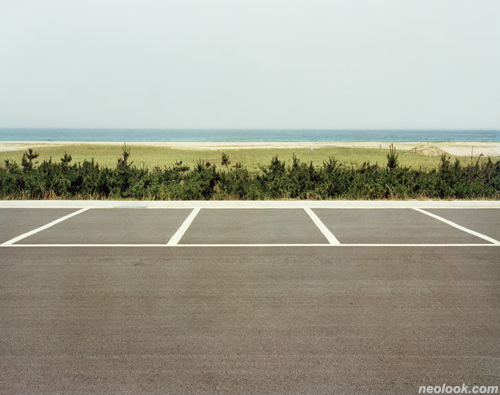
- 김혜원_34개의 야외 주차장-영덕 대진해수욕장_디지털 C 프린트_11×14inch_2009
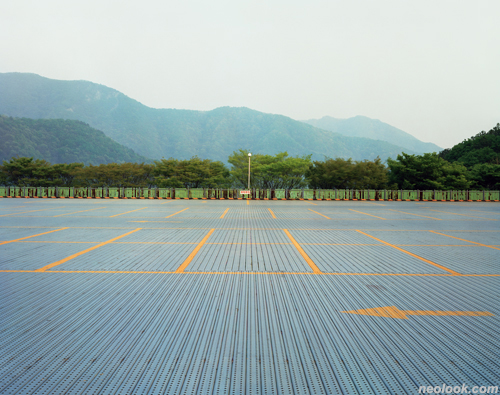
- 김혜원_34개의 야외 주차장-대둔산_디지털 C 프린트_11×14inch_2007
그리하여 삶의 터전으로서의 자연 환경을 문화 소비를 위한 인공 경관으로 변형시켜 놓음으로써 자본주의 시대의 공간 조직 체계와 문화적 가계도를 보여주는 이 사회적 풍경들은 처녀지인 '자연(Nature)'에서 경작지인 '문화(Culture)'로의 '땅'의 변형의 역사를 성찰한 지리시학(geopoetics)이 되고자 한다. 과학과 기술 문명이 생태론적 자연관을 분리하고 해부해 놓은 데 대한 사진적 성찰을 바탕으로, 인간중심주의가 주도하는 근대화 프로젝트 아래 파괴되고 훼손되는 자연의 실상 나아가 인간과 공존해야 할 야생의 녹색 환경을 환기시키며 자연의 생명 원리가 문화의 최고 진보 형태임을 보여주기를 바란다. ■ 김혜원
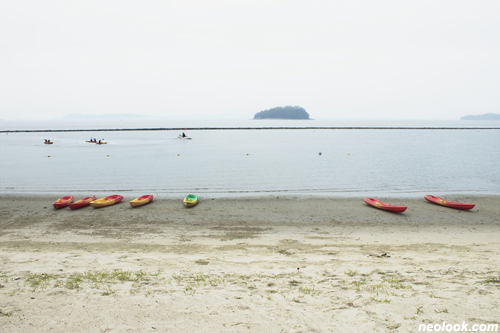
- 김혜원_금수강산 프로젝트-인공 해수욕장 #01_피그먼트 프린트_11×14inch_2014

- 김혜원_금수강산 프로젝트-인공 해수욕장 #02_피그먼트 프린트_11×14inch_2014
『Meditation Seeking for Ecotopia』 is my solo exhibition in 『2016 Contemporary Art Ruhr-Innovative Kunstmesse』 that is held in Zollverein, Essen in Germany, one of UNESCO World Heritage Sites, as it is selected as a supporting program of exhibition abroad of Jeollabuk-do Culture & Tourism Foundation. A subject matter of this exhibition is our natural environment damaged by human hands and geography changed by civilization and its photographs are landscapes seeking for the world of ecotopia symbolizing 'Green'. In other words, I took ecology as my work method and have focused on consistently showing my works about topography and environment destroyed, transformed and consumed in the era of consuming culture of industrial capitalism. ● 「The Series of Yongdam dam-Landscapes」(2001) took its subject matter from changed topography at 'Yongdam' village in Jinan-gun, Jeollabuk-do, where country land was being extensively destroyed and nature was being despoiled because of Yongdam dam construction and the alternative route construction due to the submerged roads. 「Commercial Landscapes」(2006) was a record of commercial landscapes and topography in which nature became one of expensive products and incited consumption, by representing charging leisure facilities in the middle of nature. 「Thirty-four Outdoor Parking Lots」(2009) said about our social and cultural reality of environment destruction and consumption culture, showing outdoor parking lots in the middle of nature where 'natural' scenery of 'land' had been changed into 'artificial' landscape of signs such as asphalt, cement, steel plates, straight lines and arrow marks. 「Geumsugangsan(the beautiful natural scenery of the Korean Peninsula) Project-Artificial Beaches」(2014) explored the meaning and the value of Geumsugangsan, showing us artificial beaches where sands from the other region were paved on the mud and the wood floor for walking in the coast were built after damming out the sea. ● Like this, although my photographs were archive works of times reality and social circumstances, recording topography and geography, real state of material civilization and consumption culture of capitalism age by capturing present conditions of Korean landscapes, they tried to stand in the vague boundary between documentary photography and fine art photography. They tried to expose poetic and lyrical atmosphere, based on restrained expressions and formal aesthetics such as frontality out of perspective, objectivity and neutrality out of subjectivity, keeping certain distance from objects, quiet viewpoint of viewer, middle tones and pastel colors and formative and minimal images. They tried not to forget the aesthetic perspective of reality and illusion, and struggle and balance between them instead of advocating culture criticism and environment protection as propaganda. ● Therefore, these social landscapes, later artificial landscapes for cultural consumption changed from originally natural environment as a base of life, showing space organization system and cultural family tree of capitalism age try to be geopoetics investigating history of transformation of 'Land', from virgin land 'Nature' to cultivating land 'Culture'. I hope they will show the fact that life principle of nature is a supreme progressive form of culture reminding the real state of nature destroyed and extorted by the name of modernization project taken lead by anthropocentricism and further arousing the fact that wild green environment should co-exist with humans, based on photographic reflection that civilization of science and technology separates and dissects ecological view of nature. ■ Kim, Hye-won
Vol.20161028b | 김혜원展 / KIMHYEWON / 金惠苑 / photography

